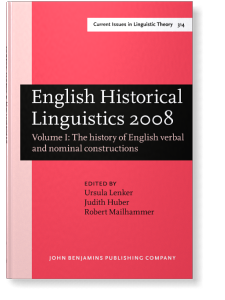English Historical Linguistics 2008
Selected papers from the fifteenth International Conference on English Historical Linguistics (ICEHL 15), Munich, 24-30 August 2008.
Volume I: The history of English verbal and nominal constructions
The fourteen studies selected for this volume – all of them peer-reviewed versions of papers presented at the 15th International Conference on English Historical Linguistics 2008 (23–30 August) at the University of Munich – investigate syntactic variation and change in the history of English from two perspectives that are crucial to explaining language change, namely the analysis of usage patterns and the social motivations of language change. Documenting the way syntactic elements have changed their combinatory preferences in fine-grained corpus studies renders the opportunity to catch language change in actu. A majority of studies in this book investigate syntactic change in the history of English from this viewpoint using a corpus-based approach, focusing on verbal constructions, modality and developments in the English noun phrase.
The book is of primary interest to linguists interested in current research in the history of English syntax. Its empirical richness is an excellent source for teaching English Historical Syntax.
Volume II to be announced soon.
Published online on 26 October 2010
Table of Contents
-
Acknowledgements | pp. vii–viii
-
Introduction: Capturing and explaining syntactic change in the history of EnglishUrsula Lenker, Judith Huber and Robert Mailhammer | pp. 1–8
-
part iVerbal constructions
-
“Þonne hate we hine morgensteorra”: On verb complementation in Old EnglishNils-Lennart Johannesson | pp. 11–28
-
Tracking and explaining variation and change in the grammar of American English: A case study, with evidence from the TIME CorpusJuhani Rudanko | pp. 29–44
-
Prevent and the battle of the -ing clauses: Semantic divergence?Elina Sellgren | pp. 45–62
-
Prescription or practice? Be/have variation with past participles of mutative intransitive verbs in the letters of Joseph PriestleyRobin Straaijer | pp. 63–78
-
On the idiomatization of “give + O + to” constructionsMinoji Akimoto | pp. 79–94
-
The clausal complementation of good in extraposition constructions: The emergence of partially filled constructionsAn Van linden | pp. 95–120
-
part iiModality and (marginal) modals
-
The ‘fail to’ construction in Late Modern and Present-Day EnglishThomas Egan | pp. 123–142
-
The interplay of modal verbs and adverbs: A history of mæg eaþeJerzy Nykiel | pp. 143–164
-
Current change in the modal system of English: A case study of must, have to and have got toJoanne Close and Bas Aarts | pp. 165–182
-
part iiiDevelopments in the English noun phrase
-
Discontinuous quantificational structures in Old EnglishArtur Bartnik | pp. 185–196
-
Genitive variation in letters, history writing and sermons in Late Middle and Early Modern EnglishTeo Juvonen | pp. 197–214
-
part ivSyntactic variation and change through contact
-
On the use of beon and wesan in Old EnglishIlse Wischer | pp. 217–236
-
The reflexes of OE beon as a marker of futurity in early Middle EnglishMargaret Laing | pp. 237–254
-
Stylistic fronting in the history of EnglishMasayuki Ohkado | pp. 255–278
-
Subject and Word index | pp. 279–282
Cited by (1)
Cited by one other publication
This list is based on CrossRef data as of 18 july 2024. Please note that it may not be complete. Sources presented here have been supplied by the respective publishers. Any errors therein should be reported to them.
